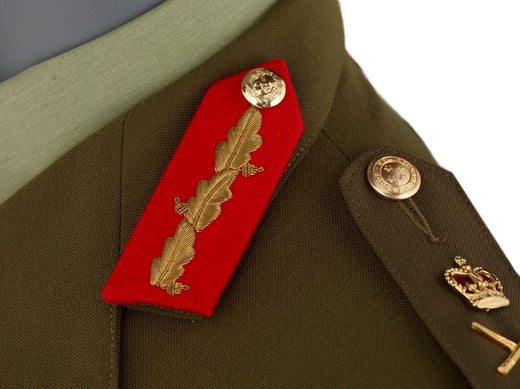The gorget has been a part of military uniforms since ancient times, with its origins dating back to Roman legionnaires in the 5th century. In modern times, it is most commonly seen on officers’ dress uniforms as an ornamental piece worn around the neck. Although its use may have changed over time and its purpose may differ between countries, the gorget patch remains an important symbol of rank and authority for many militaries today. In this blog post, we'll explore the history behind the iconic gorget patch and how it's used by different armies around the world. We'll also look at how it has evolved over the years and how its symbolism can be seen in contemporary culture. So, let's get started!
The word gorget is derived from the Latin word ‘gorgeria’, which means throat protector. This refers to its original purpose of protecting a soldier’s neck in battle. Over time, it has become a symbol of rank, most commonly associated with officers’ uniforms. It is typically made from metal and can be decorated with any number of patterns or symbols. In some cases, it may also feature the symbol of an army or regiment, making it a highly symbolic accessory for military uniforms.
The gorget patch has a long and varied history, but the first known instance of it was in the French army of 1550. This type of patch became increasingly popular among European armies during the 17th century, with many countries adopting their own versions. By the 18th century, most militaries around the world had adopted some form of gorget patch, including the United States Army.
Today, gorgets are still used by various militaries around the world. The most recognizable is the American version, which consists of a stylized representation of an eagle bearing two stars on a metal plate. While this particular design has remained largely unchanged for centuries, other countries have adapted their own designs to reflect their own unique cultures and histories.
Australia Generals, Brigadiers and Colonels wear gorget patches, known colloquially as red tabs, on the collar.
During the Boer War, a khaki uniform was introduced in Australia and red gorget patches were added to distinguish senior officers.
There are two types of gorget patch, both worn on the collar and identical in shape and colour, but with different design features. The gorget patch worn by a colonel or brigadier has a central line of silk gimp (the thread with a cord or wire in the centre) the same colour as the gorget patch. The patch worn by major generals and above has oak leaf embroidery on the full-size patch and a strip of gold braid on the smaller patch.
There are some variations in the gorget patch dependent on the members’ corps.
Members of Nursing Corps wear a silver silk gimp.
The senior officers of three corps wear a gorget patch of a different colour: the Chaplains Department wears a purple patch; the Medical Corps wears a dull cherry; and the Dental Corps wears burnt orange patches. Senior officers of the Australian Army Cadets wear a royal blue gorget patch.



